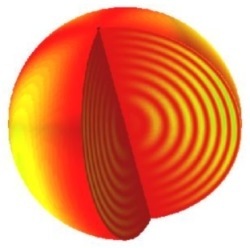  Johannes Kepler: 1571-1630 |
|
 |
|||
| The Kepler satellite at Ball Aerospace & Technologies Corp. |
  Johannes Kepler: 1571-1630 |
|
 |
|||
| The Kepler satellite at Ball Aerospace & Technologies Corp. |

 Figure (Top): Comparison of the size of the Sun to the smallest and largest red-giant for which oscillations have been detected with Kepler. Never before have star-quakes been discovered in such a wide variety of red-giant stars. Figure (Right): A plot of the dominant oscillation frequency versus temperature for all red-giant stars in which oscillations have been detected (open diamonds). Open squares show the position of bright, unevolved stars (including the Sun) for which oscillations had been detected prior to the Kepler mission. |
 |
 Figure (Top): Stars in the cluster NGC6819 in a brightness versus temperature diagram. As stars age they move from the lower left to the upper right in the diagram (white arrows). Stars in a cluster are formed at the same time but with different masses. Although the stars share a common age we see some stars (less massive) down at the bottom, while others (heavier stars) have already become red giants (top right) because heavier stars age faster. The insets show Kepler data of the stellar oscillations, which reveal the increasing size of the stars towards the top right of the diagram with larger stars having longer oscillation periods (corresponding to lower frequency, or pitch. See figure to the right). Figure (Right): So-called Fourier spectral representation of the Kepler data for 10 selected stars in the cluster NGC6819, which show the power of the oscillations over a large range of frequencies. The location of the oscillation frequencies are marked by vertical dotted lines. The stars are sorted in brightness with the brightest at the top. The large and bright red giants show lower oscillation frequencies than the smaller giants at the bottom. |
 |
 Figure based on one by Hans Deeg, from 'Transits of Extrasolar Planets' |
Move mouse over figure
to view animated transit (884 K continuous loop GIF,
requires JavaScript to be enabled); Click on figure to
view or download MPEG animation (783 K). problem? The dimming of the light caused by a Jupiter sized planet moving across a Sun-like star is about 1%, while an Earth-sized planet will only block less than 100 parts per million (0.008%). The duration of a transit is about 10 hours long. |
 |
 |
 |
|
| Kepler
field of view on the sky |
Kepler
viewing zone (artist's impression) |
The
Kepler eyes |
| Synergies between stars and
planets Since the Kepler data are used for both planet search and asteroseismology there is an obvious synergy, which we intent to exploit. Kepler applies asteroseismology as a tool to constrain the properties of the stars around which planets are being detected. In particular, the size of the stars is imprinted in the stellar oscillations and can therefore be deduced from asteroseismolgy, which will aid the determination of the size of the transiting planets. Software has been developed by members of our group in Sydney to determine the size of stars, and is part of the analysis package used to core team analysing the planet hosting stars. Who are we? The Stellar Oscillations Group at SIfA is involved in the target selection and analysis of Kepler data. Stars that we are particularly interested in are solar-like stars, M- and K-giant stars, oscillating stars in eclipsing binary systems and stellar clusters. Our group members are: Tim White, Dennis Stello, Charles Kuehn, Othman Benomar, and Tim Bedding. |
 A transit of a giant planet in orbit around a giants can look very similar to a transit of a small Earth-sized planet around a Sun-like star. |
|
| Launch Vehicle: | |
United Launch Alliance Delta II Rocket |        |
|
| Launch Site: | Kennedy
Space
Center, Cape Canaveral Air Force Station (Florida) - Launch Complex 17 - Pad 17-B |
|||
| Launch Time: |
6 March, 2009, 22:49 EST
(local time in Florida), 7 March, 2009, 03:49 (UT), 7 March, 2009, 14:49 Australian EST. |
|||
| Satellite Orbit: |
Kepler follows an
Earth-trailing orbit around the Sun, with a period of 53 weeks, one week more than Earth. |
|||
| Mission length: | 3.5 years, but can be
extended by 2.5 years, after which it become difficult to down link the data due to its distance from Earth. |
|||
 Kepler orbit |
  |
|||
| To view the launch go on youtube or NASA mission page. |  After one minute the solid boosters (in red) were ejected |